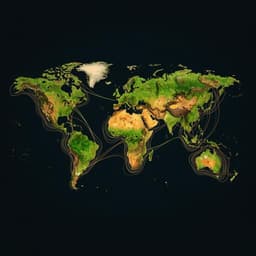
Environmental Studies and Forestry
Climate change drives widespread shifts in lake thermal habitat
B. M. Kraemer, R. M. Pilla, et al.
Lake surfaces are experiencing alarming warming, impacting how organisms adapt to their changing thermal habitat. Researchers analyzed extensive temperature data from 139 lakes, revealing significant habitat shifts that threaten biodiversity. Discover how these changes particularly affect tropical lakes and what conservation efforts might help safeguard lake species. This research was conducted by Benjamin M. Kraemer, Rachel M. Pilla, R. lestyn Woolway, Orlane Anneville, and others.
~3 min • Beginner • English
Introduction
Global warming is increasing lake surface temperatures worldwide, altering thermal structure and ecosystem processes. As available thermal habitat over specific temperature ranges shrinks or expands, organisms may face mismatches with their thermal tolerances, potentially disadvantaging native species and facilitating non-native species. Because most lake taxa are ectothermic and movement is constrained within lake boundaries, shifts in thermal habitat are of particular concern for biodiversity. Thermal habitat change is complex: temperatures vary vertically, horizontally, and seasonally within lakes, and many lakes show deep-water cooling during stratified periods due to strengthened stratification and changes in water clarity. These contrasting mechanisms complicate predictions of thermal habitat shifts in response to global warming. The study aims to quantify long-term thermal habitat change across diverse lakes and evaluate how ecological constraints on seasonality and depth exacerbate species’ exposure to thermal change.
Literature Review
Prior studies document rapid and variable warming of lake surface waters globally and emphasize the influence of climate change on lake stratification, mixing regimes, and ecological dynamics. Research has shown that warming effects can vary across depth and space within lakes, with evidence of deep-water cooling in some systems due to stronger stratification and transparency changes. Seasonal warming metrics alone can misrepresent full-annual impacts. Ecological literature highlights potential community reorganization, species range shifts, and altered phenology in response to warming, with generalists potentially tracking changing conditions more effectively than specialists. Tropical ectotherms may be particularly vulnerable due to narrower thermal tolerances stemming from low environmental variability.
Methodology
Study design and data: The authors compiled long-term temperature profiles from 139 lakes across six continents, representing 69.3% of Earth’s surface freshwater volume (70.6 × 10^3 km^3 of 101.8 × 10^3 km^3). The dataset includes over 32 million temperature measurements. Time series lengths ranged from 15 to 101 years (mean 36 years), with an average of 29 profiles per year, starting no later than 2000 and ending no earlier than 2000. For lakes >169 km^2, in situ profiles were combined with AVHRR satellite-derived surface temperatures (validated RMSE ≈ 0.55 °C) to capture horizontal variability.
Data processing: Temperature data were linearly interpolated across depth (largest gap ≤ 0.1 × mean depth). Temporal interpolation used spline models with a Kalman filter to produce continuous daily series over the consistent seasonal window for each lake (mean seasonal coverage 245 days; excluded periods without regular measurements). Large lakes were gridded into ~1,000 km^2 bins, with depth and time interpolations performed per bin. The output resolution was daily in time and variable in depth (0.1 m near-surface, 1 m below 10 m, 100 m below 1,000 m) to balance coverage and computation.
Thermal non-overlap (TNO): Each lake’s time series was split into baseline and recent halves, iteratively at the 30th, 50th, and 70th year quantiles; TNO values were averaged across splits. For each split, 10,000 temperature values were sampled from each period a and b, repeated 10 times (total 300,000 values per lake), with sampling probability volume-weighted (depth increment × cross-sectional area). For large lakes, area was apportioned by spatial bins. Kernel density estimations (KDEs) of temperatures for periods a and b were compared; TNO was defined as the symmetric difference of KDEs divided by their union, expressed as a percentage. Null non-overlap (TNO0) was computed by randomly partitioning years into two groups; standardized TNO (TNOs) = TNO − TNO0, so identical distributions yield ~0%. KDE overlap was computed at 100 evaluation points using the ‘overlapping’ R package.
Habitat restrictions: To emulate ecological constraints, temperature comparisons were restricted to subsets of days (seasonal limit, S_lim) and volumes/depths (volumetric limit, V_lim), each scaled from 0 (no restriction) to 0.95 (5% of available range). Actual day windows and volume bins were derived from each lake’s seasonal coverage and total volume, respectively; volume bins were translated to depth bins. Discrete factorial combinations of S_lim and V_lim (0, 1/2, 2/3, 5/6, 8/9, 12/13, 19/20) were analyzed.
Modeling drivers: Boosted regression trees (BRT) related TNOs to predictors: time series characteristics (start/end year, start/end day-of-year, mean samples per year, trends in sampling frequency and seasonal coverage), lake mean depth, absolute latitude, S_lim, V_lim, and split position. A 100-fold cross-validation with 70–30% splits by lake was used. Learning rates were tuned to exceed 1,000 trees per model. BRTs were also used to remove variation attributable to time series coverage differences by setting those variables to their medians and adding residuals back to predictions to derive lake-specific adjusted TNOs. Whole-lake annual mean temperature trends (volume-weighted) were computed with Theil–Sen slopes and compared to TNOs.
Key Findings
• Whole-lake temperatures increased in 77% of lakes with a mean warming rate of +0.12 °C per decade.
• After adjusting for time series coverage and standardizing against null, mean thermal non-overlap (TNOs) across lakes (1978–2013) was 6.2% (median 5.2%; inner quartile range 4.5–6.9%).
• Habitat constraints substantially increase TNOs: restricting to 5% of depths raised average TNOs from 6.2% to 9.7% (+3.5%); restricting to 5% of days raised it to 11.0% (+4.8%); restricting both depth and season raised it to 19.4% (+13.2%), exceeding the additive effect.
• The influence of restriction type varies with morphometry: seasonal restrictions affect shallow lakes most; depth restrictions affect deep lakes most.
• BRT results show TNOs increases with mean depth (especially when seasonal restrictions are weak) and is strongly associated with latitude: contrary to expectations, tropical lakes exhibit substantially higher TNOs than lakes at other latitudes, partly due to lower baseline temperature variability amplifying standardized change.
• Thermal non-overlap is only weakly related to whole-lake warming rates (Kendall r ≈ 0.10), reflecting that TNOs captures both warming and cooling across the water column.
• Case examples: Lake Zürich overall TNOs = 16%; restricting to P. rubescens’ optimal habitat (July–September, 5–20 m) increases TNOs to 22%. Lakes with high endemism also show elevated TNOs (e.g., Baikal 5.5%, Biwa 9.9%, Tanganyika 15.4%, Victoria 18.5%).
Discussion
Thermal non-overlap provides an ecologically relevant measure of thermal habitat change, capturing simultaneous warming and cooling across depths and seasons that whole-lake mean trends can obscure. Elevated TNOs in the tropics, despite slower surface warming, suggest heightened sensitivity where baseline temperature variability is low and species’ thermal tolerances are narrower. Ecological constraints on movement across depth and season markedly increase exposure to thermal change, implying specialists and taxa limited by light, oxygen, phenology, or life-history cues are more vulnerable than generalists. The strong morphometry dependence indicates that management priorities may differ between shallow and deep systems. Lakes with high biodiversity and endemism frequently exhibit high TNOs, raising concerns about extinctions, community reassembly, and altered nutrient and energy pathways. Conservation strategies should emphasize reducing within-lake barriers to tracking suitable temperatures (e.g., limiting anoxia, maintaining transparency where appropriate) and enhancing among-lake connectivity to facilitate range adjustments.
Conclusion
By integrating more than 32 million observations from 139 lakes, the study introduces a standardized, volume-weighted thermal non-overlap metric that quantifies thermal habitat change and its amplification under realistic ecological constraints. Results reveal widespread but heterogeneous thermal habitat shifts, strongest impacts under combined seasonal and depth constraints, and elevated sensitivity in the tropics and in deeper lakes under certain conditions. The framework can inform conservation prioritization by identifying systems where biodiversity is at heightened risk. Future research should: (1) link thermal non-overlap to observed biotic responses across taxa and trophic levels; (2) extend the modular approach to incorporate other habitat determinants (oxygen, light, nutrients); (3) refine species-specific vulnerability assessments considering life histories and thermal breadth; and (4) evaluate management interventions that enhance vertical and seasonal habitat accessibility and connectivity among water bodies.
Limitations
• The TNO metric’s magnitude depends on baseline temperature variability; low baseline variance (common in tropics) inflates standardized change for equivalent absolute shifts.
• Habitat restriction extremes (e.g., 5% of depth and season) are illustrative and may be rare; real species’ constraints vary and include additional factors (oxygen, light, nutrients) not directly modeled here.
• Some lakes’ temperature changes may reflect climate variability modes (e.g., AMO influence on Lake Annie) in addition to anthropogenic trends.
• Differences in sampling intensity, seasonal coverage, and interpolation introduce uncertainty, though analyses standardized for coverage and used cross-validation.
• Combining in situ and satellite data for large lakes may introduce scale mismatches despite validation; spatial binning mitigates but does not eliminate this.
• TNO is agnostic to direction of change and does not by itself indicate biological benefit or harm; species responses depend on tolerance and interactions.
Related Publications
Explore these studies to deepen your understanding of the subject.







